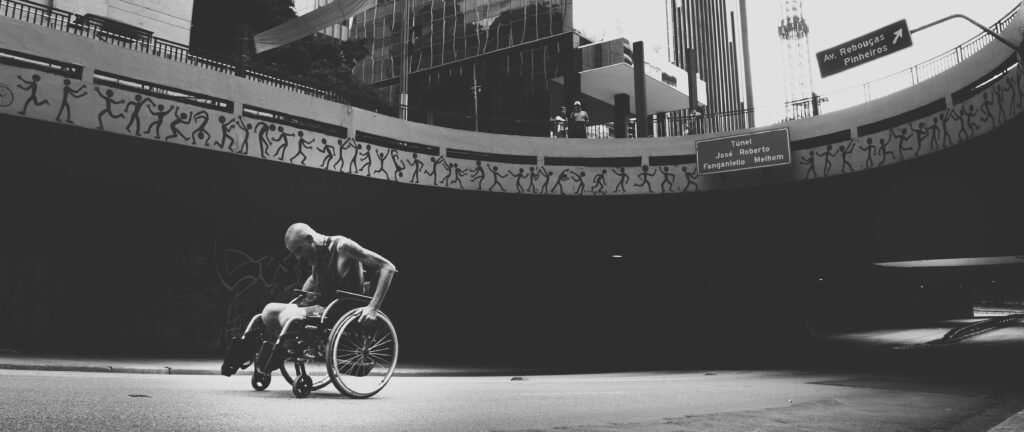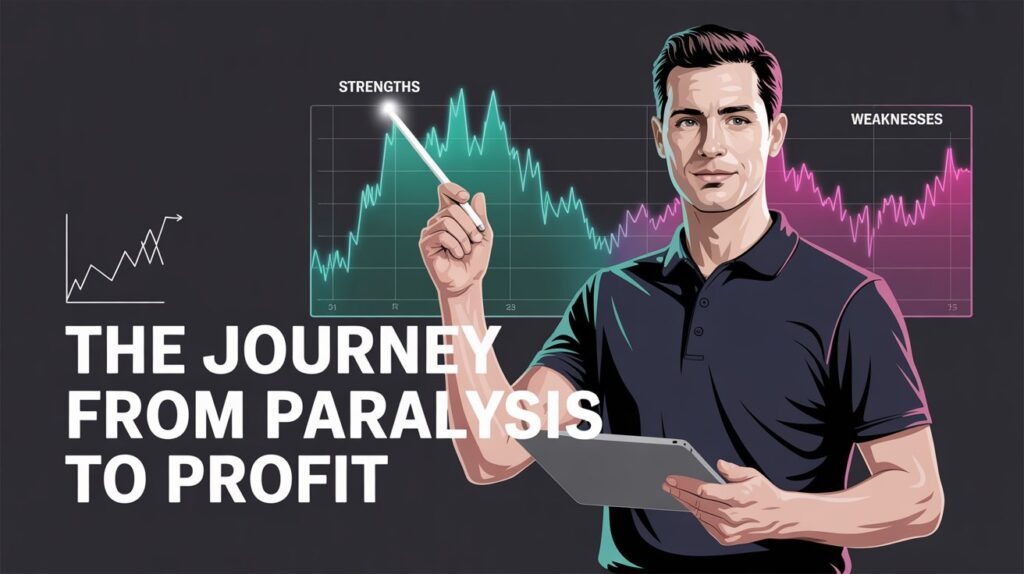The Trade I Never Chose
One moment, I was a healthy, active man with my whole life ahead of me. The next, I was lying on my back, unable to move, my mind trying to comprehend the impossible: I might never walk again. That day, I unknowingly made the biggest trade of my life. Not in the markets. But in life itself.
I traded mobility for life. I traded certainty for chaos. I traded who I was for who I would become.
This is my story. Not just about surviving a spinal cord injury, but about what I gained from the greatest loss I ever experienced. It is a story about “trading” not financial, but personal, emotional, psychological and how those very lessons eventually led me to become a trader in the truest sense of the word.

The Initial Trade-Off: Loss and Gain
The Trade of Mobility for Life
The injury happened in a moment. It was swift, cruel, and irreversible. A spinal cord injury left me paralyzed from the neck down. In that instant, everything I knew about life, the simple act of walking, dressing or holding a pen was gone.
I didn’t choose this trade, but life made it on my behalf. I lost physical independence, but I gained time. Time to reflect, to observe, to think. I had traded my body’s freedom for the gift of stillness.
Trading the Familiar for the Unknown
Before the injury, I was a man of action. My days were filled with movement, activity, ambition. I had a plan, a direction. But life doesn’t always honor plans.
In the days that followed, I found myself trading everything familiar for the unknown. Hospitals replaced my home. Wheelchairs replaced shoes. The roadmap of life I once followed was now blank. But here’s the thing about blank pages: they hold potential.
Trading Physical Abilities for New Skills and Perspectives
Trading Physical Labor for Intellectual Pursuits
With my body limited, my mind became my primary tool. The stillness forced upon me became the space where new ideas emerged. I discovered a deep curiosity for financial markets, psychology, and human behavior. Trading became my intellectual playground.
I studied charts, systems, emotions, and risk. The same resilience I needed to face my injury became essential in this new world. Trading wasn’t just about money, it was about mastering myself.
Trading Speed for Precision
When your movement slows down, you notice details you used to miss. A passing thought. A flicker of emotion. A hesitation before action. This heightened awareness helped me refine my decision-making. In trading, success lies in details: entries, exits, patience.
Physical speed was gone. But I gained mental precision.
Trading One Form of Independence for Another
Before the injury, independence meant doing everything myself. Now, it meant asking for help, embracing technology, building routines, and mastering my environment.
In a strange way, I became more self-reliant. I no longer relied on muscle, but on mindset. And this shift prepared me for trading. An activity where no one can think for you, act for you, or feel your losses for you. It’s all on you.
3. Trading Emotional Landscapes: Grief and Resilience
Trading Breakdown for Breakthrough
At first, it felt like a crash, like my life had hit the kind of drawdown that wipes your account clean. The kind where you stare at the screen, frozen, questioning every move that got you there. That was me, lying in a hospital bed, trying to make sense of a life that had just been liquidated.
But over time, I realized even a broken chart can start a new trend. I stopped obsessing over what I lost and started focusing on what I could still build. I began to see recovery not as a full reversal, but as a slow grind, small wins, compounding.
Hope didn’t arrive as motivation. It came as discipline. Showing up. Doing the work. Believing that one green candle, one good day was enough to keep going.
Trading Panic for Presence
There were nights my mind would spiral. Like watching a fast-moving market with no stop-loss in sight. That mental volatility is brutal. But eventually, I learned to breathe through the chaos. To sit in the discomfort instead of reacting to it.
I treated my thoughts like price action. Not every move needed a response. Sometimes, the best decision was to do nothing. To observe. To wait. That’s where clarity lives in presence, not panic.

Trading Fear of the Future for Focus on Today
Every trader knows the market doesn’t care about your past wins or losses. It only reacts to the present. I had to learn the same about life.
I stopped trying to predict how long recovery would take. Stopped forecasting every possible scenario. Instead, I focused on one thing: today. What could I do with the time and energy I had now?
Each rehab session became a rep in the mental gym. Each journal entry, a backtest of my own mindset. The future wasn’t mine to control, but the way I showed up today, that was a trade I could make.
Trading Isolation for Connection
Injury isolates you, physically, emotionally, socially. But I learned that connection is a choice. I started reaching out. To family. To friends. To others who had walked similar paths.
In trading, too, the journey is often lonely. But mentors, communities, and shared stories can make the difference between burnout and breakthrough. Connection heals.
Trading Self-Pity for Empowerment
I remember the exact moment I let go of self-pity. I was staring at the ceiling, thinking about everything I had lost. Then something shifted. I told myself: “This is not how your story ends.”
From that moment, I decided to take control. Of my thoughts. My actions. My future. That mindset was a trade from helplessness to empowerment.
Here’s my Linkedln – Shahzaib Khan

Trading External Expectations for Internal Strength
Trading Societal Limitations for Personal Achievements
People often assumed I was broken. That I’d live a lesser life. That I couldn’t contribute. I decided to prove them wrong not with anger, but with action.
I started learning again. Building again. Contributing again. I set goals that challenged me, whether it was moving a finger or mastering a trading setup.
This wasn’t about proving others wrong. It was about proving to myself that I still had power.
Trading Dependence for Advocacy
Over time, I began sharing my journey. Writing, speaking, mentoring. I connected with others facing similar challenges. What began as dependence evolved into leadership.
When I teach someone how to manage risk or control their emotions in trading, I’m also passing along the emotional discipline that came from navigating my own trauma. I’ve traded pain for purpose.
Also read this: Emotional Discipline in Trading: How to Stay Calm During Drawdowns
The “Trading” Mindset: Lessons for Life and Trading
Risk Assessment and Management
Every day after my injury involves managing risk from transfers to medical decisions to emotional boundaries. That same risk-conscious mindset now informs my trading strategy. I don’t chase profits. I manage losses.
In both life and trading, surviving is winning.
Adaptability and Flexibility
Spinal cord injury is the ultimate curveball. If you don’t adapt, you get stuck. Trading is the same. Markets shift. Setups fail. Strategies evolve. Rigidity breaks you. Flexibility makes you.
Patience and Long-Term Perspective
Recovery isn’t measured in days. It’s measured in years. Small gains matter. Progress isn’t linear. These truths taught me to think long term to zoom out.
In trading, too, success isn’t about one good day. It’s about consistency over years.
Understanding Volatility and Uncertainty
My life turned upside down in a second. That’s volatility. But I’m still here. That’s resilience.
Uncertainty isn’t something to fear. It’s the canvas where possibility lives. This mindset shift helps me stay calm when markets get wild. Because I’ve faced bigger storms than a red candle.
Takeaways:
- Life and trading both demand the same currency: mindset.
- Every loss contains a hidden trade. Every setback is an offer. What you do with it matters.
- Resilience isn’t loud. Sometimes it looks like getting up, again and again, even when no one is watching.
- You can lose everything and still gain something far more powerful: purpose.
Conclusion: My Greatest Trade
I didn’t choose my spinal cord injury. But I did choose how to respond. And in doing so, I made a trade.
I traded a life of ease for one of meaning.
I traded the predictable for the profound.
I traded tragedy for transformation.
And in many ways, I became a trader not just of assets, but of emotions, mindsets, and decisions. Trading has taught me discipline, patience, and focus. But it was life’s greatest loss that taught me the deepest truths.
If you’re facing something hard right now a loss, a failure, a moment when everything changes. Look closely. There may be a trade hidden inside it. And what you gain, in time, might just change everything.
“You can’t control the cards you’re dealt, just how you play the hand.” — Randy Pausch



